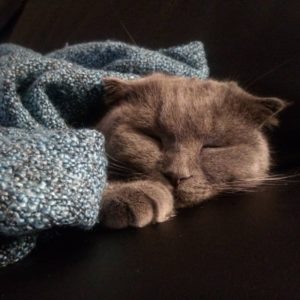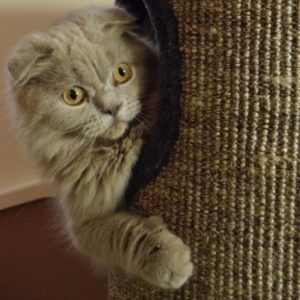Scottish Fold Joint Pains and Problems
 In a previous article, I talked about how the Scottish fold is amongst the best pets a family would deserve. Those balls of fur are the Universes’ way of saying sorry for anything bad happening to us. They seem to be the perfect pets. And with a lifespan of 15 years, they will warm on our laps for a very long time indeed.
In a previous article, I talked about how the Scottish fold is amongst the best pets a family would deserve. Those balls of fur are the Universes’ way of saying sorry for anything bad happening to us. They seem to be the perfect pets. And with a lifespan of 15 years, they will warm on our laps for a very long time indeed.
But is life all milk and honey? It is not. Not for us and especially for them. Why? This breed has some health issues associated like joint problems caused by Osteochondrodysplasia and. After all, these cats are “mutants”. It may sound odd, but that’s right, mutants. And here is why.
Origins
In 1961, on a farm in the Scottish town of Perthshire, a cat named Susie was born with a natural genetic deformity. It was mostly harmless, as it blocked her ears from developing the necessary cartilage to keep them raised. Hence why the breed has those cute little folded down ears, making her look like an owl.
The problem arose when the cat was then taken by an enthusiast and was bred with numerous short-haired cat. This is how the Scottish fold breed was born.
Why is it bad
Since we first domesticated wildlife, breeding has mostly gone from functionality to cuteness. And one question that we humans have asked ourselves was: ”How can I make this thing cuter?”. And the answer is simple: ”By giving it disgusting genetic deformities, of course!”
Do not understand me wrong, I love the Scottish Folds, but they must be bred correctly. Otherwise, serious health issues can and will occur.

As we all know, purposefully encouraging any genetic deformities to thrive and dominate will result in bad things. Sure, the breed, like many others humans have created looks extremely cute, but this comes however at a price: health.
And the cuter and quirkier the breed is (think of Pugs, Poodles and French Bulldogs), the health problems become more severe. And this one breed of cat is not exempt from the severe one by any chance.
Problems of the Scottish Fold
The average Scottish fold will start to exhibit symptoms of disease anywhere between the age of four to six months. Of course, if left unchecked, said diseases will worsen though aging, so make sure to visit the vet regularly.
As for well established, dangerous diseases, the Fold suffers mainly from two. Could be more, but those are the ones they suffer from most. In no particular order, said diseases are as follows:
Osteochondrodysplasia
The bread and butter disease. It is what gives them the distinct ear shape. The problem is that it also affects other parts of the body. It is most commonly manifested as the distortion of limb bone shapes and severe arthritis. It can also manifest from as early as 7-8 weeks of age. This is why Scottish Fold may suffer joint problems and pains.
In scientific terms, if the cat has two copies of the gene, it is homozygous. If it is only one, it is heterozygous. Studies[1] show that all cats with folded ears will eventually develop Osteochondrodysplasia. The only difference is that homozygous cats will manifest this disease sooner and more severely and the heterozygous ones will progress slower and more limited.
The problem here is a subjective one, seeing as how some heterozygous cats manifest this disease partially, others fully. Some Experience progressive crippling arthritis, whilst others experience it slower and sometimes in a lesser fashion.
Usually, heterozygous cats will start to experience the disease once arthritis and the addition of body exostoses start to develop. This has another side effect.
Congenital Osteodystrophy:

Because of it, the cartilage is prone to become abnormally thick and very inflexible at the base, due to them fusing together. As it does, more and more of its tail, legs, and paws will thicken and shorten, resulting in its inability to walk. The paws are also prone to swelling, due to excessive amounts of new bone forming around the joints. All in all, it is very close to paralysis due to the symptoms listed below.
Despite not being life-threatening, it is very painful and can actually kill due to stagnation of the muscles. This, combined with potential mental depression might lead it to a slow, painful and silent death.
The biggest problem here is that has no known cure. Glucosamine supplements and other joint treatments can elevate some of the pain, but it is usually unsalvageable. In some circumstances, any long-term use of painkillers will lead to other undesirable side-effects.
On a few occasions, it was reported that there are other ways to elevate the pain. Mathews at al reported that welding the affected joints together and then removing the lump has decreased lameness and pain in cats.
Another, Hubler at al reported that engaging in radiation therapy has appeared to work in relieving pain in the cat. However, this comes with the risk of developing cancer. On many occasions, and when the condition is at an advanced stage, the vet will usually propose euthanasia.
Scottish Fold Health Issues Symptoms
You will know that this is forthcoming when one or more of the following symptoms manifest themselves:
- The tail becomes short and thick at the base;
- Bones become thicker and more tender on the touch;
- It becomes lethargic;
- It doesn’t jump or play anymore (then again, might also be due to old age);
- It is obvious that it is in great pain;
- Legs may limp;
- Its legs might appear very stiff, just like a marching soldier;
- Lacks coordination and moves slowly.
- Joint Problems and Pain
What to do to prevent such occurrences:
- Periodically pay a visit to the vet for signs of stiffness, pain or lameness;
- Periodically take them through x-ray/CT/MRI scans;
- Give them proper nutrition;
- Pamper them with love and attention (studies have shown that a healthy mind can lead to a healthy body);
- Be prepared to grant them a final mercy if there are no other choices left.
As a side note, I wish to impart some bits of advice on how to choosing a good breeder. This is because a Fold bought from a good breeder will have its problems postponed even lessened. Also, Folds are rarer and more expensive than ”straights”, so this is what you should look for in a breeder:
- The kitten is no less than 12 weeks old. At this point, you will be able to see what kind of diseases it is suffering from and at what stage.
- The breeder must have a good reputation. This usually translates into knowing what he/she does and how to limit the severity of the diseases. This also means they vaccinate the cubs and always choose the right ones for the buyers.
- The breeder is a member of a certified breeding organization. With all the ruckus going on about the cessation of breeding Folds, this is a godsend.
- The breeder is transparent. That is when the breeder is positive in showing you any paperwork, tell you everything he/she can about the cat. This is a good sign, meaning that he/she has nothing to hide. And if so, their work must be of higher quality.
Conclusion
Although today’s article was a tad grimmer than others and I’m really sorry about that. But it is because you must know what you are getting yourself into. Scientists and activists worldwide call for the incrimination and the cessation of continuing this breed. Scientifically, there are not yet enough reports to condemn it fully, but there are enough to raise great concerns for the health of the species.
If your Scottish Fold has any health problems, my best advice is to take it to the vet as soon as possible.